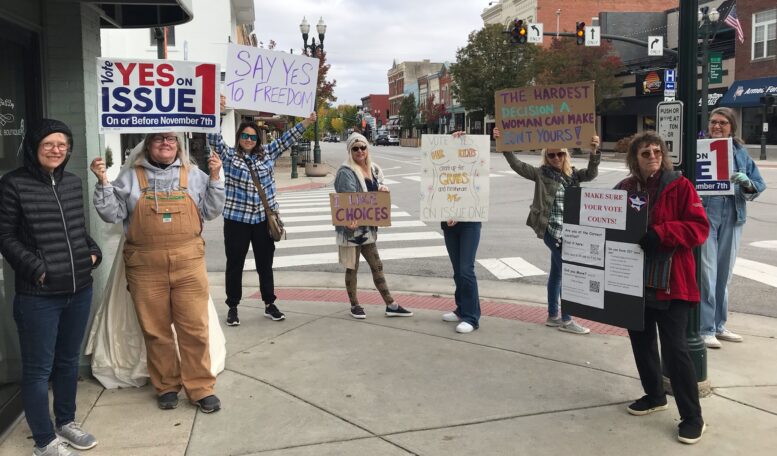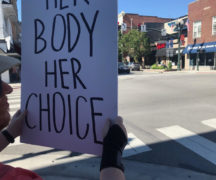BY NICK EVANS
Last week’s election marks a significant victory for reproductive rights and recreational marijuana advocates. In both cases, support for those issues has traditionally aligned with left of center voters, but Tuesday’s results didn’t fit that model.
In a state that has taken a hard right turn, two seemingly liberal ballot measures easily out-performed former President Donald Trump and U.S. Sen. J.D. Vance, R-OH.
For politicians and strategists, it’s an outcome that’s tantalizing or confounding, depending on your perspective. Do those ballot measures suggest Ohio’s electorate is easing from red to purple? Or is Ohio’s partisan alignment unchanged while voters’ opinions on the issues have shifted?
In the days following the election Democrats and Republicans offered their view of the case. Ohio Democratic Party Chair Liz Walters previewed a 2024 in which Republican candidates up and down the ticket have to answer for their stance on reproductive rights.
“Ohioans showed us last night, resoundingly, what our decision is on abortion rights here in Ohio,” she said. “And so I think this will continue to be a big part of the discussion next year.”
Gov. Mike DeWine, on the other hand, downplayed the results. He said Issue 1’s supporters successfully framed the issue as a choice between their proposal with exceptions for rape or incest and existing law which doesn’t carry them.
“Ohioans, clearly by a large majority believe that there should be exceptions,” DeWine said. “Every time we come up with that there should be exceptions for rape and incest. I think that certainly played a role in people making their decision.”
Notably, DeWine signed the state’s six-week abortion ban into law early in his first term. That law has no such exceptions.
Mapping the Issues
Issue 1 and Issue 2 did particularly well in the state’s urban centers, and particularly badly along the Ohio’s far west border. That’s unsurprising given those areas’ partisan alignment. But moving beyond those examples, there are several notable departures from recent precedent.
Both measures did very well along Lake Erie. University of Cincinnati political scientist David Niven explained that portion of Northeast Ohio used to be a Democratic stronghold. In more recent elections, though, Republicans have whittled that bulwark down to just three or four counties.
Issue 1 cruised in counties like Lake and Portage and picked up narrower but still convincing wins in Ashtabula, Geauga, Ottawa and Wood counties. In the region, Issue 2 notched many of the same victories, but often by a smaller margin. Sandusky and Huron Counties were two notable shifts. Issue 2 picked up narrow majorities in both counties while Issue 1 failed.
Issue 2 also did noticeably better in southern Ohio. Border counties like Brown, Lawrence and Meigs favored recreational marijuana, but flatly rejected the reproductive rights proposal. A bit further north, counties like Ross, Hocking and Fairfield all supported Issue 2.
Niven argued one of the night’s biggest surprises was Issue 1’s performance in Delaware County.
“Delaware County has not voted for a Democrat for President since Woodrow Wilson,” he said. “That is more than a century. They voted for (Barry) Goldwater, this is such a Republican county. And they voted resoundingly — resoundingly — to enshrine reproductive rights in the state constitution.”
Take Paulding and Van Wert Counties in Northwest Ohio. Both counties rejected both initiatives. But voters there were far more hostile to the reproductive rights amendment, which did about 16 points worse than recreational pot.
Neighboring counties offered a few surprises as well. Union County to the west and Licking County to the east were both narrow wins for Issue 1. Like Delaware, both have seen a notable uptick in suburban and exurban development in recent years.
Issue to Issue
Although in broad strokes there are a lot of similarities between the Issue 1 and 2’s results, once you dig into the margins, there are significant gaps between the two.
The biggest gap, however, shows up in Lawrence County which saw a nearly 18-point swing between voters approving marijuana and rejecting abortion rights.
From Niven’s perspective, that kind of drastic over-performance for Issue 2 is bad news for Democrats. “Those places are basically closed to Democrats,” he said. “You can close up shop in those counties.” While both issues have to do with the scope of government, he argued, there are clear differences in the way Republican voters think about pot and abortion.
Comparing theissues to one another also underscores Ohio’s regional divides. In Union County, for instance, marijuana ran about a point better than reproductive rights. Next door in Logan and Champaign Counties, it was more like 11 points.
But several traditionally Republican counties saw both issues winding up in the same ballpark. In Delaware, Tuscarawas and Medina Counties — all Republican leaning — Issue 1 actually out-performed marijuana.
The Issues compared to Donald Trump
That sort of pattern stood out to University of Akron political scientist David Cohen.
“I think Republicans are very scared of their own Republican women voters in the suburbs at this point,” he explained.
For all his seeming dominance of the 2024 primary, Cohen argued there’s a chunk of Republican that remain “distressed” with a Trump-led GOP.
“They’re not MAGA people; they’re not Trump supporters,” Cohen explained. “And votes like this may be an indication that that they may be willing to vote with the other party or maybe stay home in November.”
In 2020, Donald Trump won all but seven counties. In most of those counties he won, it looks like that advantage remains intact. Still there are several counties though that flipped. Northeast Ohio, which Niven put his finger on, holds a handful.
Trump narrowly won Lorain, but Issue 1 did about 11 points better. The amendment out-performed Trump by smaller margins in Wood, Erie, Lake, Portage, Trumbull and Mahoning counties as well.
And in the counties where Democrats won in 2020 — Cuyahoga, Franklin, Hamilton, Lucas and Summit — Issue 1 out-performed President Biden.
The Issue 2 comparison shows a similar pattern with narrower margins. Northeast Ohio still saw the initiative outperforming Trump’s marks, but not by much.





